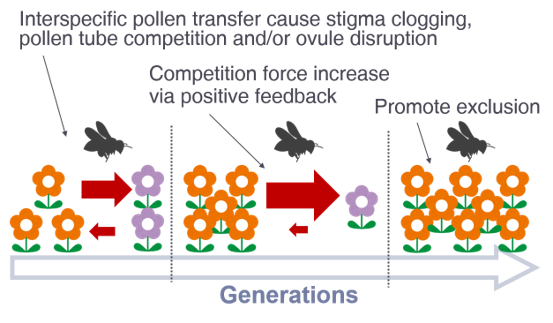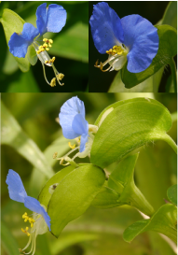Example
Coexistence mechanism of native plant species: to unify the understandings of fields and theories
Plants are the most important species making up the ecosystem. To know the mechanism for creating their diversity is essential for maintaining a sustainable global environment.
The two anual Commelina species, Commelina communis (Cc) and C. communis f. ciliata (Ccfc), were target species in this study. Cc and Ccfc completely share the growing environment, flowering time, and pollinators. The traditional theory could not explain why such similar flowers, expected to have a strong competitive relationship, can coexist sympatrically. First, Based on the field observation and experiments, we found that the mechanism of autonomous self-pollination can reduce competition. Then, we constructed a mathematical model based on these findings and assumed various scenarios. Finally, we showed that the evolution of selfing, involving autonomous self-pollination, can promote sympatric coexistence of closely related plant species. There are a lot of things still unknown to understand about competition and coexistence among plant species. By organizing the complex phenomena seen in the field and continuing to explore general rules, it is expected that we will be able to obtain valuable knowledge when considering the conservation and management of sustainable ecosystems.


The two anual Commelina species, Commelina communis (Cc) and C. communis f. ciliata (Ccfc), were target species in this study. Cc and Ccfc completely share the growing environment, flowering time, and pollinators. The traditional theory could not explain why such similar flowers, expected to have a strong competitive relationship, can coexist sympatrically. First, Based on the field observation and experiments, we found that the mechanism of autonomous self-pollination can reduce competition. Then, we constructed a mathematical model based on these findings and assumed various scenarios. Finally, we showed that the evolution of selfing, involving autonomous self-pollination, can promote sympatric coexistence of closely related plant species. There are a lot of things still unknown to understand about competition and coexistence among plant species. By organizing the complex phenomena seen in the field and continuing to explore general rules, it is expected that we will be able to obtain valuable knowledge when considering the conservation and management of sustainable ecosystems.

Fig. 1. The mechanism how the pollinator-mediated competition promote the competitive exclusion.

Fig. 2. Commelina communis (upper right), C. communis f. ciliata (upper left) and both two flowers growing in same place.
Representative
